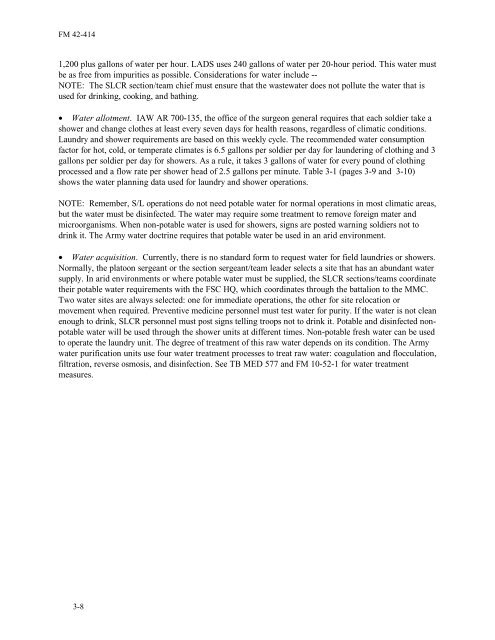Tactics, techniques, and procedures for - Army Electronic ...
Tactics, techniques, and procedures for - Army Electronic ...
Tactics, techniques, and procedures for - Army Electronic ...
Create successful ePaper yourself
Turn your PDF publications into a flip-book with our unique Google optimized e-Paper software.
FM 42-414<br />
1,200 plus gallons of water per hour. LADS uses 240 gallons of water per 20-hour period. This water must<br />
be as free from impurities as possible. Considerations <strong>for</strong> water include --<br />
NOTE: The SLCR section/team chief must ensure that the wastewater does not pollute the water that is<br />
used <strong>for</strong> drinking, cooking, <strong>and</strong> bathing.<br />
• Water allotment. IAW AR 700-135, the office of the surgeon general requires that each soldier take a<br />
shower <strong>and</strong> change clothes at least every seven days <strong>for</strong> health reasons, regardless of climatic conditions.<br />
Laundry <strong>and</strong> shower requirements are based on this weekly cycle. The recommended water consumption<br />
factor <strong>for</strong> hot, cold, or temperate climates is 6.5 gallons per soldier per day <strong>for</strong> laundering of clothing <strong>and</strong> 3<br />
gallons per soldier per day <strong>for</strong> showers. As a rule, it takes 3 gallons of water <strong>for</strong> every pound of clothing<br />
processed <strong>and</strong> a flow rate per shower head of 2.5 gallons per minute. Table 3-1 (pages 3-9 <strong>and</strong> 3-10)<br />
shows the water planning data used <strong>for</strong> laundry <strong>and</strong> shower operations.<br />
NOTE: Remember, S/L operations do not need potable water <strong>for</strong> normal operations in most climatic areas,<br />
but the water must be disinfected. The water may require some treatment to remove <strong>for</strong>eign mater <strong>and</strong><br />
microorganisms. When non-potable water is used <strong>for</strong> showers, signs are posted warning soldiers not to<br />
drink it. The <strong>Army</strong> water doctrine requires that potable water be used in an arid environment.<br />
• Water acquisition. Currently, there is no st<strong>and</strong>ard <strong>for</strong>m to request water <strong>for</strong> field laundries or showers.<br />
Normally, the platoon sergeant or the section sergeant/team leader selects a site that has an abundant water<br />
supply. In arid environments or where potable water must be supplied, the SLCR sections/teams coordinate<br />
their potable water requirements with the FSC HQ, which coordinates through the battalion to the MMC.<br />
Two water sites are always selected: one <strong>for</strong> immediate operations, the other <strong>for</strong> site relocation or<br />
movement when required. Preventive medicine personnel must test water <strong>for</strong> purity. If the water is not clean<br />
enough to drink, SLCR personnel must post signs telling troops not to drink it. Potable <strong>and</strong> disinfected nonpotable<br />
water will be used through the shower units at different times. Non-potable fresh water can be used<br />
to operate the laundry unit. The degree of treatment of this raw water depends on its condition. The <strong>Army</strong><br />
water purification units use four water treatment processes to treat raw water: coagulation <strong>and</strong> flocculation,<br />
filtration, reverse osmosis, <strong>and</strong> disinfection. See TB MED 577 <strong>and</strong> FM 10-52-1 <strong>for</strong> water treatment<br />
measures.<br />
3-8

















